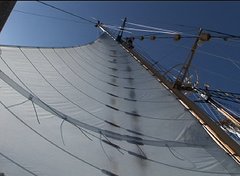May 29, 2007. Palmyra Atoll. We're in Palmyra now - an atoll that the Nature Conservancy has set up as a preserve and natural laboratory. A consortium of universities and museums has established this unique atoll as a research station.
Along with consortium scientists, the students of Stanford@SEA are conducting their missions in the small boats around the lagoons by running transect lines to continue their observations for comparison with Kiritimati and Washington islands. Because there are few people living on Palmyra, there is a trophic cascade that is rich with top predators (aka sharks).
We saw three-foot white tip sharks yesterday during our transects. The booby team (Karen and Melissa) began working with renowned TOPP bird researcher Scott Shaffer and a graduate student, Hillary, from Stanford. We've been out for two nights in a row using a modified fishing pole to catch the boobies as they are nesting and than quickly attach a GPS transmitter.
I found my skills with poles and monofilament transferred quickly to catching boobies out of trees. The work is done in the middle of the night. The first night we were rained on and were still getting used to being on land at night; it's a sharp contrast to being at sea. The jungle was rich with life -- crabs moving across our path, spiders, eels along the water's edge and the remarkable cries of the sooty tern colonies.
Last night we worked under moonlight and stars; it was spectacular. We've recovered the first two tags. One track shows a booby heading toward our next destination -- Kingman Reef. Our interest is in how the land and sea connect here and the relationship between one atoll and the next. We hope to recover 4 GPS tags tonight. If so, Melissa and Karen will have the key to understanding how the red-footed boobies use the ocean to feed their chicks. -- Barb Block, chief scientist
Tuesday, May 29, 2007
Subscribe to:
Post Comments (Atom)


1 comment:
it really very good.
I love it !
I like it !
thanks :)- .
Bathmate
Post a Comment